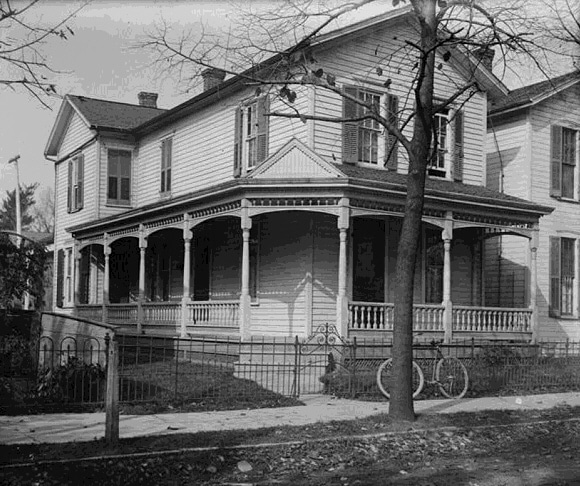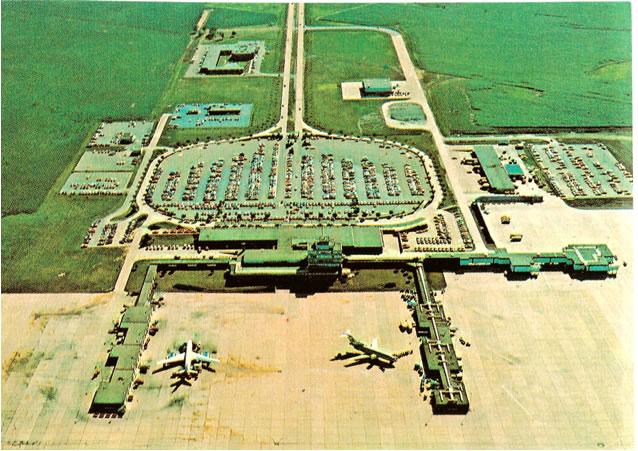A city with an amazing aviation past
If you had to pick the world’s original aviation city, you would probably mention Kitty Hawk, North Carolina, where the Wright brothers made their first flight. Or you might pick spots around the country and world where aircraft are produced like Seattle or Toulouse. Or you might even pick a city with exceptionally heavy air traffic like Atlanta or London Heathrow. You would probably wouldn’t think of Dayton, Ohio (unless, of course, you were a particularly knowledgeable avgeek with a focus on the history of aviation). Yet Dayton is, to many, inarguably the original aviation hub. Home of Wright-Patterson AFB and the US Air Force Museum, the city is awash in aviation history.
The Birthplace of Aviation

The Wright brothers flew their first flight at Kitty Hawk but they called Dayton home. The brothers owned a bicycle shop in the city. It was there that they tinkered with designs that eventually led to the first heavier-than-air powered aircraft to fly with a pilot onboard.
Two years after the Kitty Hawk flight, the brothers would fly the Wright Flyer III in Dayton. Their work and the increasing interest in aviation would lead to the formation of Dayton Airport in 1928, making it one of the oldest airports in the world (in the Top 20, if not the Top 10). While that original airport came up against a bit of hardship, particularly in the face of the start of the Great Depression, it had so much support that it would eventually be turned into a municipal airport with three runways, opening with flights offered to the public in 1936.
Later in its life, the Dayton airport would go on to serve the U.S. military during World War II, as the U.S. Army leased the airport and it became the Dayton Army Airfield from 1942 to 1945. Afterward, the Federal Government deeded the airfield back to the City of Dayton, along with the surrounding military facilities, adding up to more than 550 acres of property. At that time, as a result, Dayton Municipal Airport was the largest commercial airport in Ohio.
The military’s interest in the airport still remained. Just two months after the property was deeded back to the city, a division of the Ohio Air National Guard was re-activated and stationed at the airport through the 1950s, with hundreds of military and civilian employees working and living at the airport.
Commercial Service to Dayton
Three days after Dayton Municipal Airport opened in 1936, TWA’s forerunner, Trans Continental and Western Airways, began service to Dayton with three flights daily. Dayton would later become a TWA focus city. In 1957, TWA provided the most departures out of Dayton, with 56 per week. At that same time, American provided 13 and Lake Central, four. Non-stop flights served New York, Chicago, Detroit, Cleveland, Pittsburgh and Cincinnati. TWA was the first airline to begin jet service from the airport, in 1961, with Convair 880 aircraft flying on a route to Chicago (at the same time, the airport was further expanding, adding a new terminal to the tune of $5.5 million). TWA even offered widebody connecting service on their L1011s to the west coast.

City’s Boom Makes Dayton a Commercial and Freight Hub
TWA’s focus on Dayton would be surpassed by Piedmont Airlines in the 1980s. Piedmont offered non-stop service between Dayton and nearly 30 destinations, as far away as California. The hub, Piedmont’s second in the nation (and followed only by hubs in Baltimore and Syracuse), was said to defy analyst expectations by exceeding traffic predictions. At the time, Piedmont was the 10th largest airline in the United States, and the 17th largest in the world. It joined the rank of major airlines as its annual sales exceeded $1 billion.
Additionally, at the time, Dayton was home to three major Fortune 500 companies. When you added in the business traffic from Wright-Patterson Air Force Base, the city was thriving.
The non-stop West Coast service to Los Angeles began in 1984. It was also Piedmont’s first foray into first-class service. In 1985, Piedmont opened a reservations center at the airport. Once Piedmont merged with US Airways, US Airways would continue operating out of the Dayton hub for several years.
Dayton’s Boom in Cargo Service
At the same time that Piedmont was operating heavily out of Dayton, freight carrier Emery Worldwide grew Dayton into a freight hub. They built an air freight sortation facility at the airport, completed in 1981. From 1946, when Emery was the first freight forwarder to receive a carrier certificate from the U.S. government, until 1986, Energy would remain the largest freight forwarder and integrated air carrier in the country. Its Dayton facility was one of the world’s largest air freight facilities, through the 90s. Emery constantly built onto the facility, making it larger and larger.
The facility, later taken over when UPS acquired Emery, would operate until 2006, when UPS closed the facility and moved its operations to Louisville, Kentucky.
A Sharp Decline
In 1986, the City of Dayton celebrated owning the airport for 50 years and the airport marked a passenger milestone of 4.5 million passengers. In order to accommodate increased traffic, a $50 million renovation was planned and then completed in 1989.
However, other factors would cause airlines like Piedmont and Emery and their successors to either move their hubs away from Dayton, or to close up shop altogether. One of these factors would have certainly been the decrease in manufacturing and industrial work in and around Dayton. For decades, the city was home to major players in American industry — NCR, Mead Paper Company, Dayco, Phillips Industries and others. In the 1980s and 1990s, however, jobs began moving out of Dayton, the population shrunk and, as a result, travel to the area, both business and leisure, shrunk with it.
Dayton would soon find that its once booming hub of an airport had become little more than a regional spot on the map.
Into the Modern Age of Aviation, One Step at a Time
Dayton, though, is nothing if not resilient. The airport continued to welcome other airlines following the de-hubbing of its largest carriers, both commercial and cargo, and it made baby steps toward keeping its facilities modern.
The first low-cost carrier came to the airport in 1995, AirTran Airways.
Yet more renovations occurred in the late 1990s, with a $25 million investment in the terminal building. The renovations lasted until 2002 and included new climate control systems, lighting, windows, doorways, ceilings, carpeting and shopping and dining outlets.
Following the tragic events of 9/11 in 2001, the Dayton airport would be one of the first airports in the nation to re-open for business.
Shortly after, Frontier Airlines began service between Dayton and Denver in 2005. Southwest joined Frontier in offering budget service to Dayton with flights to Denver as well, in 2012, and would also eventually offer service to other destinations, such as Florida, Baltimore and Chicago. It was estimated that this service would increase passenger traffic in the airport by 15 percent or more.

However, both Southwest and Frontier would pull out of the airport shortly after and move on to airports in Cincinnati and Columbus, just an hour away. Frontier discontinued its Dayton flights in 2013, facing competition from Southwest. Southwest Airlines lasted until 2017, though it gradually reduced its service before its eventual defection to Cincinnati.
Allegiant Air took Frontier’s place in 2015, soon becoming the only budget carrier serving Dayton, offering service to Florida.
All the while, the airport focused on improvement projects, such as the construction of a new air traffic control tower in 2011, a new multi-level parking garage in 2009, runway and roadway projects in 2009 and further ticketing counter and parking expansions in 2018.
Dayton International Airport Today
Is there hope for Dayton International Airport in the future? Dayton leaders and airport officials seem to think so, as do travelers who’ve recently visited the airport’s beautiful new terminal facilities.
In 2017, the airport welcomed 138 aircraft operations per day, across its three paved runways.
The airport is currently served by American Airlines, Delta Air Lines and United Express (with seasonal Allegiant Air services). As of September 2019, there were 669k passenger enplanements on the year, with American Airlines (American Eagle) taking credit for most of those. That number represents a slight decrease from 2018. Passengers can currently fly nonstop to Atlanta, St. Petersburg, Charlotte, Chicago, Dallas, Denver, Minneapolis, Detroit, New York, Orlando, Philadelphia, Houston and Washington, D.C.
The airport also reported this year that it had doubled the number of charter passengers it serves since 2015. Much of this growth is attributed to the launch of a music center near Dayton, which draws in headlining acts that often fly private aircraft into the airport, as well as increasing activity at casinos near Dayton. Sun Country Airlines is the largest provider of charters through the airport.
Additionally, cargo service still takes place at the airport, with FedEx Express flying to and from Memphis. (Otherwise, though, save for this smalls service, the cargo ramp sits empty.)
The airport is hoping to attract more carriers with renovations moving forward, including low-cost carriers such as Spirit Airlines and Frontier. The renovations, which recently wrapped up, included new architectural features, wider TSA lanes, new restrooms, new USO space for military members and new shopping and dining options. Overall, the airport looks great now, though its future can’t be based on renovations alone.
The new interim director of the airport also has their eye on attracting more service to the airport. The city will face some difficulty in the years ahead, especially if they’re looking to land Southwest again, considering the airline’s difficulties following the MAX saga have led to significantly reduced growth by the airline and a reduction of service from other markets that are traditionally better known. New services from Frontier, Allegiant and Spirit are not out of the question though.
The city that invented modern aviation is stuck between celebrating their past, and making investments that they hope will drive a more prosperous future.

Please have someone proof read before posting. I know it’s “just” a blog. But come on, “But you would probably wouldn’t think of Dayton, Ohio” is horrendous.
We fixed it. Thanks!